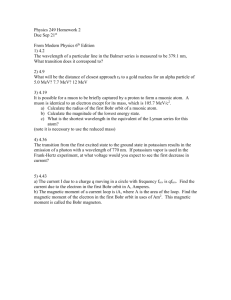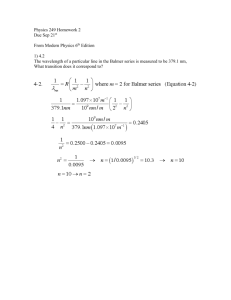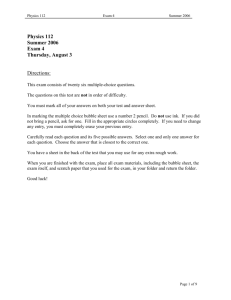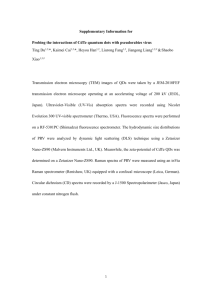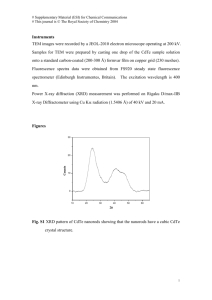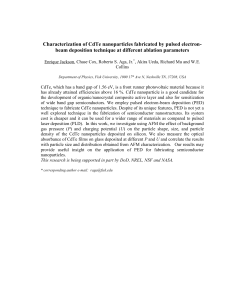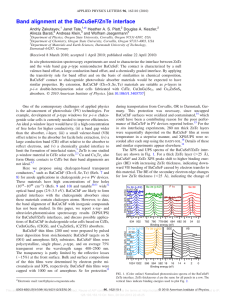Diluted Magnetic Semiconductors
advertisement
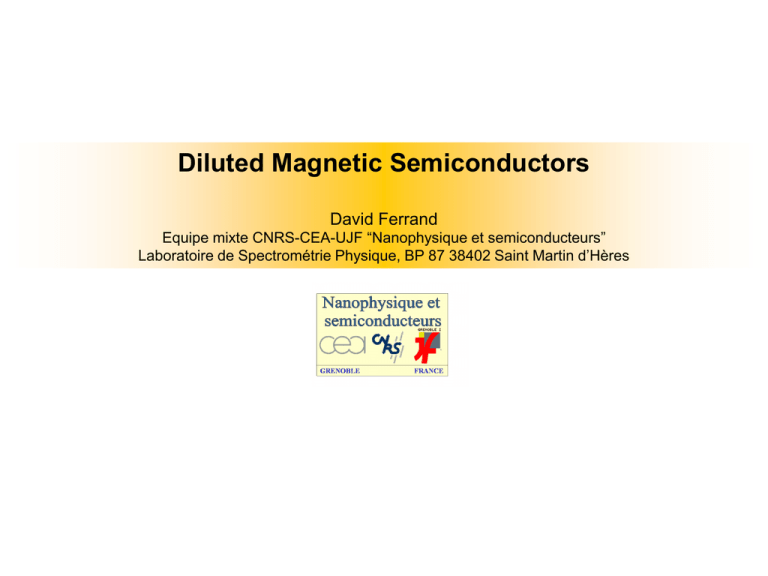
Diluted Magnetic Semiconductors David Ferrand Equipe mixte CNRS-CEA-UJF “Nanophysique et semiconducteurs” Laboratoire de Spectrométrie Physique, BP 87 38402 Saint Martin d’Hères Injection and manipulation of spins in semiconductors Electrical spin injection, spin transport, tunnel structure M. Kohda et al, Jpn. J. Appl. Phys., Part 2 40, L1274 (2001) R. Mattana et al, Phys Rev Lett, 90 166601 (2003) Spin manipulation Kroutvar et al., Nature 432,81 (2004) Outline I : Spins localized in II-VI heterostructures 1. Modulation doped heterostructures : II-VI Ferromagnetic quantum wells 2. CdTe quantum dots doped with a single Mn atom II : High band gap diluted magnetic semiconductors GaMnN/ZnCoO ZnCrTe 1. GaMnN, ZnCoO 2. ZnCrTe II-VI semimagnetic heterostructures I Valence mixte I, II, III… II II III IV V VI VII H VIII He Li Be B C N O F Ne Na Mg Al Si P S Cl Ar K Ca Sc Ti V Cr Rb Sr Y Zr Nb Mo Cs Ba La Hf Ta W Mn Re Fe Co Ni Cu Zn Ga Ge As Se Br Kr Ru Rh Pd Ag Cd In Sn Sb Te I Xe Os Ir Pt Au Hg Tl Pb Bi Po At Rn Mn : 4s2 3d5 Cd0.7Mg0.3Te CdTe Cd0.7Mg0.3Te Isoelectronic element S=5/2 localized spins Cd0.88Zn0.12Te substrate CdTe/CdMgTe quantum wells Magnetic alloys : Cd1-xMnxTe, Zn1-xMnxTe With a large Mn solubility up to 75% Almost perfect semiconducting properties ZnTe CdTe CdTe ZnTe ZnTe substrate CdTe/ZnTe quantum dots L Magnetic properties : Short range antiferromagnetic interactions a J2, J3~0.5K N.N pairs J1~20K J. Furdyna et al, JAP 64 R29 (1988) kT << J1 xeff 0,0 0,05 0,1 0,2 0,3 0,4 0,5 0,05 0,04 0,04 0,03 0,03 0,02 0,02 0,01 0,01 0,00 0,0 0,1 0,2 0,3 Mn content x 0,4 0,00 0,5 Small concentration of free spins Studies at low temperatures with diluted alloys C0 xeff T TAF C0 x T Tcw p type modulation doped CdMnTe QWs Surface doped CdMnTe QW Magnetic quantum well Cd(1-x)MnxTe 80 Å spacer Barrier CdMgTe Substrate 15 nm < z < 60 nm After surface oxydation 2D hole gas -2 Hole Gas Concentration (cm ) Nitrogen W. Maslana, 2003 E1 HH1 10 11 10 10 0 100 200 300 400 500 600 Cap layer Thickness (Å) 80 Å Mn Compositions 0-4% Hole densities 1-3 1011 cm-2 Mn Compositions 0-11% Hole densities 1-2 1011 cm-2 Magneto-optical spectroscopy : Giant Zeeman effect H e .S (re - RMn ) h .S (rh - RMn ) ±1/2 E1 Sz +1 z Photon -1 HH ±3/2 HH Excitons Holes : ~-100 meV nm3 < 0 ~25 meV nm3 > 0 Electrons : HH -1 Excitons ( - ) S z Xhh N Mn V + B=+4 T HH +1 G.S - N0 ( - ) xeff S z N0~few 1022 cm-3 N0~0.2 eV N0~-1 eV 1670 1680 T=1.9K 1690 1700 1710 1720 1730 1740 1750 1760 Susceptibility measurements PL : Curie EnergyWeiss temperature (meV) PL Energy Photoluminescence 2.1K 11cm-2 Mn, p=1.6 10-2 11 cm PL at 2.1K, 2.4% 2.4% Mn, 1.610 (meV) 1665 1665 1664 Susceptibility 4.2K + 0G - PL (u.a.) 100G 1.65K 1663 1664 1662 1663 4.2K 1.65K 1661 200G 1662 300G 1661 0 500 0 400 Magnetic field (Oe) 0 500 1660 Energie (meV) 400 Magnetic field (Oe) 400G 1650 0 1670 Inverse susceptibility (T/meV) Haury et al, 1997 Inverse susceptibility (T/meV) Interactions ferromagnétiques induite par le gaz 2D Tcw~-TAF=-2K < 0 0.05 undoped p-doped Tcw ~ 2 à 3 K > 0 0.05 undoped 0.00 Coll. P. Kossacki, Warsaw -2 -1 0 1 p-doped 2 3 4 Temperature (K) 5 Electrical control through an electrostatic gate V p doped QW barriers undoped n doped H. Boukari et al, Phys. Rev. Lett. 88, 207204 (2002) PL Intensity (a.u.) a 0V b -1V 4.2 K 4.2 K 3.03 2.80 2.97 2.82 2.19 2.19 2.05 2.05 1.87 1.88 1.65 1.49 K 1.65 1.49 K 1700 1710 Tc 1700 1710 Energy (meV) Hole gas depleted Comparison with mean field model predictions TC C0 xeff P - TAF 2 2D D.O.S 2D h AF Effective Mn content : xeff L 6 4 3 2 1 0 0 1 2 3 4 5 6 Mn content x (%) 7 8 9 10 Critical temperature (K) 5 Temperature (K) 4 TC > TCW ? Kossacki 2001 2 X 2.3 0 4% Mn 0 T. Dietl, Warsaw 1 2 11 -2 Carrier density (10 cm ) Magnetic CdMnTe/ZnTe QDs Strained induced CdTe/ZnTe QDs: 3D-coherent islands UHV-AFM image of CdTe QDs on ZnTe. QDs density: 1010 cm-2 h > hcSK Size: d=25nm, h=3nm (Lz<<Lx,Ly) "Stranski-Krastanow" TEM C. Bougerol. Introduction of Mn atoms (3d5 4s2 ) carrying S=5/2 localized spin Thèse L Maingault, H. Mariette CdTe/ZnTe QDs doped with a single Mn atom Single dot spectroscopy : Strained induced Cd(Mn)Te/ZnTe QDs: 6,5 MLs 100 m Mn segregation during the growth of a spacer layer PL Intensity (arb. units) d 20 m d 0,5 m 50eV Mn density = QDs density Thèse L Maingault, H. Mariette 50meV d 0,25 m 1950 2000 Energy (meV) Thèse Y. Léger 2050 2100 Reference CdTe/ZnTe QDs Reference CdTe/ZnTe QD : B=0 Growth axis z s=1/2 B=0 -1 +1 ±1 +1 -1 Jz=±3/2 // Oz Electron : s=1/2 Anisotropic hole Jz=3/2 G.S. L. Besombes et al., Phys. Rev. Lett. 93, 207403 (2004) Individual Mn-doped CdTe/ZnTe QDs Mn-doped CdTe/ZnTe QDs: 6 twofold degenerate excitonics levels Total splitting 1.3 meV S=5/2 CdTe QDs with an individual Mn spin Thèse Y. Léger Exciton-Mn Exchange Coupling S=5/2 H H 0 I e- Mn e .S I h- Mn jz .S z 2 e ( r - RMn ) I e-Mn g Mn B S Z Bz I h - Mn 3 2 h (r - RMn ) Complexe X - Mn : s=1/2 + Jz=3/2 + S=5/2 Mn2+ X Jz = -1 e h Jz 1 Jz = -1 e h -5/2 Jz = +1 e h -3/2 +3/2 -1/2 +1/2 +1/2 +3/2 -1/2 -3/2 +5/2 Jz = +1 e -5/2 h Overall splitting : Detection and manipulation of a single Mn spin +5/2 5 ( I e - Mn - 3I h - Mn ) 2 Ie-Mn=-70 eV and Ih-Mn =350 eV. Mn-Doped Individual QDs Under Magnetic Field Splitting of the six exciton lines. Diamagnetic shift. Changes in the PL intensity distribution. Large anticrossing for five of the exciton lines around 6T. Additional tiny anticrossings. NMn=0 NMn=1 II : High band gap diluted magnetic semiconductors GaMnN/ZnCoO 1. GaMnN, ZnCoO 2. ZnCrTe I Valence mixte I, II, III… II III IV V VI VII H VIII He Li Be B C N O F Ne Na Mg Al Si P S Cl Ar K Ca Sc Ti V Cr Rb Sr Y Zr Nb Mo Cs Ba La Hf Ta W II-VI : Cr2+ : 4s2 3d4 Co2+ : 4s2 3d7 Mn Re Fe Co Ni Cu Zn Ga Ge As Se Br Kr Ru Rh Pd Ag Cd In Sn Sb Te I Xe Os Ir Pt Au Hg Tl Pb Bi Po At Rn III-V Mn 4s2 3d5 Acceptor : GaMnAs 3d5 Isoelectronic : 3d4 Towards room temperature diluted magnetic semiconductors ? 2001 2002 (Zn,Co)O : (Ga,Mn)N MBE 3-6% Mn PLD 15-25% Co Tc>300K S. Sonoda et al. J.A.P. 156, 555 (2002) K. Ueda et al, APL 79 988 (2001) (Zn,Cr)Te 2003 MBE 0< x < 50% H. Saito et al, 2003 High temperature ferromagnetism still controversial : ZnCrTe - Paramagnetism + Ferromagnetism observed by SQUID - No phase diagram with the magnetic ion composition or correlation with other parameters - Transport properties weakly sensitive to magnetic ions -No sharp optical features close to band edges - No photoluminescence Tunnel junctions with (Zn,Co)O Diluted high band gap alloys : GaMnN, ZnCoO Partially filled d bands located within the gap ? Ferromagnetism mediated by electrons ? D.O.S BV e t2 BC BV e t2 E Cr2+ in II-VI Mn3+ in III-V 3d4 e BC E t2 Co2+ in ZnO 3d7 Zn1-xCoxO or Ga1-xMnxN Buffer 4x10 4 3x10 4 -1 4 Al2O3 substrate 1,7K 2,2% M n 2 Band edge Band-level transitions 3 1 2x10 1x10 4 Absorption coefficient (cm ) -1 Absorption coefficient (cm ) Grown by Molecular Beam Epitaxy: •in CREHA Valbonne (Zn1-xCoxO) C. Deparis, C. Mohrhain •in Grenoble (Ga1-xMnxN) 5x10 d-d intra-ionic transitions 4 0 1,0 1,5 2,0 2,5 3,0 3,5 Energy (eV) e 5x10 4 300K 6,6% Co 4x10 4 3x10 4 2x10 4 1x10 4 2 5 t2 < 3d BC E e t2 Band edge Disorder ? 1 3 d-d intra-ionic transitions 0 1,0 1,5 2,0 2,5 Energy (eV) D.O.S BV c - axis WURTZITE epilayer 3,0 3,5 Magneto-optical spectroscopy of intraionic d-d transitions (Ga,Mn)N : 0.03% Mn + 11T -1 2 K 11 T -3 6 5 4 L3 3 2 Tetrahedral crystal field 1 0,06 0,04 B =0 0,02 L2 -11T - 0T 0 1408 1412 1416 1418 1870 Spin allowed transition at 1413 meV S. Marcet et al, cond-mat/0604025 2006 3d4 S=2 5D 5E 1875 1880 Energy [m eV ] Energy [m eV] Mn3+ L3 L1 0,08 0,00 L1 -3 -1 Absorption coefficient [10 cm ] 0,10 B||c L2 7 (Zn,Co)O 2% Co Absorption Intensity [10 cm ] 8 Spin forbidden transition at 1876 meV W. Pacuski et al, Phys. Rev. B 73 035214 (2006) Co2+ 5T 3d7 S=3/2 2 Isoelectronic spins 4F 2E 4A 2 Ground state : Fine structure Hamiltonian parameters 1879 L1 1878 Energy (m eV) Energy (m ev) 1413,0 1412,5 L2 1412,0 L3 1411,5 L3+ 1877 1875 L1+ 1874 L2+ 1873 L3- 1872 0 2 4 6 8 10 12 14 1871 Magnetic Field (T) 0 2 5 L3 L1 3 L2 2 +1 1 0 0 5 D : G .S 0 2 4 Energy (m eV) +2 Energy (meV) 6 8 10 12 E 1412 -1 4 Magnetic Field (T) 1416 1414 L2- L1- 1876 2 1876 1875 1874 E+ 2 8 10 -2 M a g n e tic F ie ld (T ) +3/2 L1 L3 1 L2 +1/2 0 -1 4 -1 6 -1/2 A2 -2 -3/2 0 2 g//=1.91 gperp =1.98 4 6 8 10 12 Magnetic Field (T) S. Marcet et al, cond-mat/0604025 2006 Axial anisotropy : E- E(E) H ( g // - g )B Bc Sc g B.S D(Sc2 - S (S 1) / 3) Axial anisotropy : D=0.27 meV g//=2.28 Axial anisotropy : D=0.35 meV Evolution with of the magnetic ion concentration Ga1-xMnxN Zn1-xCoxO 0.8 3,0 Absorption Coefficient [1/m] In te g ra te d A re a [x 1 0 5 cm -2 ] 0.9 2,5 2,0 1,5 1,0 0,5 0,0 0,0 0,2 0,4 0,6 Mn content [%] 0,8 4A 2 2E 2A 0.7 0.6 0.5 4A 2 2E E 0.4 0.3 0.2 1,0 0.1 0 1860 1880 1900 Photon Energy [meV] 0 1 2 3 4 5 Co Concentration [%] Co2+ incorporation up to 6% Mn3+ incoporation up to about 1% W. Pacuski et al, Phys. Rev. B 73 035214 (2006) 6 1.5 T=1,7 K 3 25 0.4%Co 2 1.7KB||c 1.5 7K 1 1.7% Mn 0 0 1 2 3 4 1.0 5 Magnetic Field [T] 1.0 Zn1-xCoxO B c 20K S. Marcet, Thèse Grenoble, 11/2005 0.5 0.5 Mplan Mplan' Mc Mc A ### 2%Co 1.7K 1.5 6K 10K 1.0 20K 30K 0.5 40K 20 -MCD [deg/m] 2.0 4 Mean Spin of Cobalt 2.5 Magnetization [ B / Mn] Comparison with the magnetic properties Ga1-xMnxN 15 10 5 6% 0 0 5 10 15 Magnetic Field [T] R. Galera, Lab. L. Néel, Grenoble Ferromagnetism observed for 6% Mn : Tc~5K 0 0 0 5 10 15 Magnetic Field [T] No ferromagnetism observed up to 10% Ferromagnetism observed for PLD samples Exchange interactions with carriers Energy 0.50 CB - Reflectivity VB + A B 0.40 0.35 C 0.30 B 0.25 C 0.20 3360 0,7 x = 0.1% A 0.45 3380 3400 3420 Energy [meV] 3440 3460 0,6 2K 0,6 0,5 11T - Reflectivity (a.u) Reflectivity (e.u) 2K 0,5 0T 11T + 0,4 0,3 3490 3500 3510 3520 3530 3540 Photon Energy (meV) 0T 0,3 11T + 0,2 (Zn,Co)O : 0,4% Co 0,0 3360 3370 3380 3390 3400 3410 Photon Energy (meV) xMn = 0.004 xMn = 0.004 N0(α-β) =-1.2 eV ∆Eshift = 1 meV ∆Eshift = 6meV <Sz> = 2 0,4 0,1 (Ga,Mn)N : 0,4% Mn 11T - N0|α-β|=0.8 eV Conclusion - II-VI Heterostructures : - Carrier induced in CdMnTe quantum wells : Modulation doping or surface doping - CdTe quantum dots doped with a single Mn ions : Manipulation and detection of a single spins - High gap DMS : - High temperature ferromagnetism still controversial - GaMnN : Incorporation of isoelectronic Mn3+ ions : 3d4 Ferromagnetic exchange with holes Ferromagnetism observed at low temperature -ZnCoO : Incorporation of Co2+ isoelectronic ions Paramagnetic behavior observed up to 10% Co spin carrier exchange smaller than in GaMnN - Equipe mixte CEA-CNRS-UJF Grenoble, France L. Besombes, E. Bellet, Y. Biquard, J. Cibert, D. Halley, D. Ferrand, R. Giraud, S. Kuruda, E. Sarigianidou, H. Mariette Y. Leger, S. Marcet, L. Maingault, W. Pacuski, A. Titov - Lab. L. Néel, France, Grenoble R. Galera, M. Amara, B. Barbara, J. Cibert - Polish academy of science, IFPAN, Warsaw, Poland M. Sawicki, J. Jaroszynsky, S. Kolesnik, T. Dietl - Université de Varsovie, Pologne W. Maslana, W. Pacuski, P. Kossacki, J Gaj E. Gheraeert, LEPES, Grenoble C. Deparis, C. Mohrain, CRHEA Valbonne K. Rode, M. Anane UMP CNRS-Thales, Orsay A. Dinia, E. Beaurepaire, M. Gallart, P. Gilliot IPCMS, Strasbourg, France - Institute of Materials Science, University of Tsukuba, Japan S. Marcet,. N. Nishizawa, T. Kumekawa, N. Ozaki, S. Kuroda and K. Takita
